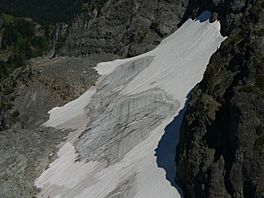Sarvant Glacier facts for kids
Quick facts for kids Sarvant Glacier |
|
|---|---|

The main body of ice
|
|
| Type | Mountain glacier |
| Location | Cowlitz Chimneys, Mount Rainier National Park, Pierce County, Washington, USA |
| Coordinates | 46°51′16″N 121°37′8″W / 46.85444°N 121.61889°W |
The Sarvant Glacier is a cool, icy river of snow and ice. You can find it high up on the northern side of the Cowlitz Chimneys. This area is part of the amazing Mount Rainier National Park in Washington, USA. Glaciers are like very slow-moving rivers made of ice. They form when snow piles up over many years and turns into ice.
Contents
Discover the Sarvant Glacier
The Sarvant Glacier is a special part of the beautiful landscape around Mount Rainier. It is a mountain glacier, meaning it forms in high mountain areas. This glacier helps shape the land over a very long time.
Where is This Icy River?
The Sarvant Glacier is located in the state of Washington. It sits on the northern slopes of a place called the Cowlitz Chimneys. These chimneys are a group of rocky peaks. The glacier is also inside the famous Mount Rainier National Park. This park is known for its stunning mountains and glaciers.
How Big is the Sarvant Glacier?
This glacier starts very high up in the mountains. It begins at an elevation of about 7,000 feet (2,134 meters). From there, it slowly moves northward. The glacier flows down to an elevation of about 6,100 feet (1,859 meters).
Around the main glacier, you can find other patches of ice and snow. These smaller icy areas are always there, even in summer. They are located to the east and west of the main Sarvant Glacier. These patches are found at different heights. Some are as high as 7,000 feet (2,134 meters). Others go down to about 5,700 feet (1,737 meters). The patches of ice on the western side are even called the Sarvant Glaciers (plural).
Who Was Henry Sarvant?
The Sarvant Glacier is named after a person named Henry M. Sarvant. He was an important explorer and mapper. In 1894, Henry Sarvant helped create maps of the Mount Rainier area. Naming the glacier after him honors his work. His maps helped people understand the mountains better.

